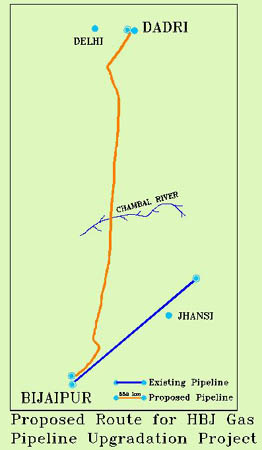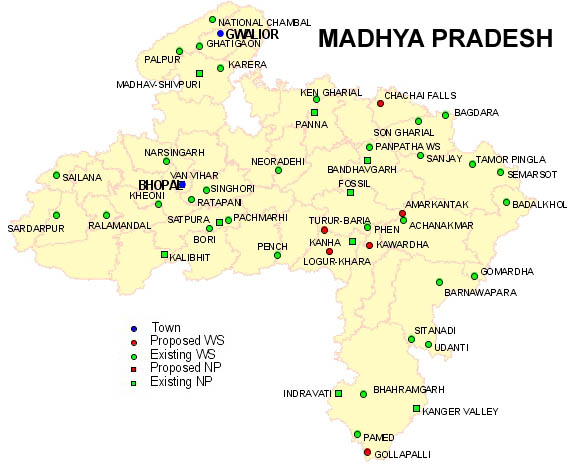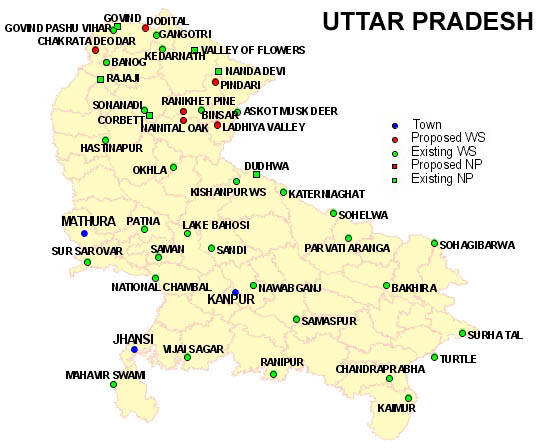Summary
HBJ Gas Pipeline Upgradation
Project Profile
This 505 km long underground pipeline would originate from the existing compressor station at Bijaipur and would terminate at NTPC station Dadri. The proposed pipeline with the diameter ranging between 71 - 76 cms will augment the throughput of existing HBJ pipeline from 18.2 to 30 MMSCMD. The areas of ecological interest en route the proposed pipeline are i) Great Indian Bustard habitat in Shivpuri district of M.P., ii) Chambal River Sanctuary in Morena district of M.P., iii) Ramsagar lake in Dhaulpur district of Rajasthan and iv) Reserved and Protected Forests of Guna Forest Division of M.P.
Predicted Impacts
-
Clearing and diversion of an area of GIB habitat for trenching would reduce the available habitat for Bustards. Construction activities and transportation and storage of material and equipment would temporarily disrupt the GIB movements. Reproductive patterns would be greatly impacted by disturbance to active nesting sites and by physical destruction of eggs during the construction phase.
-
Likely impacts of construction related activities on the Chambal River Sanctuary would result in the modification of habitats for Gharial, Gangetic Dolphin and Otter.
-
The terrestrial habitat along the banks of Chambal River harbouring Hyena, Wolf, Ratel, Porcupine, Caracal would be also impacted by the clearing of 30 m wide width of scrubland.
-
The project is likely to induce enhanced biotic pressures within the sanctuary.
-
Proposed route of the pipeline along Ramsagar lake would restrict utilization of lake side foraging habitat by migratory waterfowl. Withdrawal of water from the lake for hydrostatic testing of the pipeline would distract birds from utilizing this wetland habitats.
-
Removal of forest vegetation would be a direct loss of forest cover. The project is also likely to induce illegal encroachment for cultivation, livestock grazing and fuel wood collection.
Mitigation Measures
-
Project related developmental activities to be scheduled outside the breeding period (March to August) of GIB. Suggested period for laying pipeline through GIB habitat is October to February.
-
Creation of a new GIB Sanctuary proposed at Pohri recommended to promote enhanced conservation of GIB in other habitats.
-
Horizontal Directional Drilling (HDD) technology suggested for pipeline crossing through Chambal river.
-
Construction and transportation activities along Chambal suggested during the period between March and July.
-
Restricted withdrawal of water from Ramsagar lake recommended only during the period outside October to March for preventing disturbance to migratory waterfowl.
-
RoW within forested area recommended to be restricted to 30 m. Development of compensatory afforestation plan recommended to be developed in consultation with State Forest Department.
New access roads for the transportation of man, material and equipment not recommended to prevent project induced biotic interferences.Project Analysis
The proposed project is not likely to trigger significant impacts of irreversible nature. Most of the project impacts can be mitigated by suggested mitigatory measures.
Decision on Environmental Clearance
Based on WIIs recommendations, and subject to adherence to some stipulated conditions, the environmental clearance has been accorded to the project by the Ministry of Environment and Forests.
The proposal for creation of a new protected area - Pohri Wildlife Sanctuary has been agreed in principle both by States and Central Government.
Location Map

State Map


|
Client |
Engineers India Limited |
|
Project Team |
Project Team Principal Investigator Project Co-ordinators |
|
References |
Environmental Impact Assessment of HBJ Gas Pipeline Upgradation Project on Wildlife and Wildlife Habitats. 1993. WII - EIA Technical Report 2. Wildlife Institute of India, Dehradun. |
Last Updated: January 21, 2014









